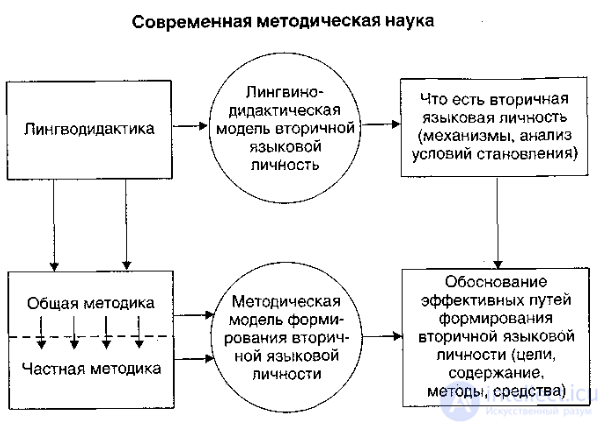Lecture
In the last years among Methodists strengthened the view of the importance of linguodidactics.
Lingvodidaktika - branch methodological. science cat justifies meaningful. components of education, training. and learning in their inseparable. connection with the nature of language and communication. This is methodological. aspect of the theory of training. AND I.
Lingvodidaktika - the general theory of mastering and knowledge of the language in terms of training.

The technique is based on data from basic sciences:
- linguistics (linguistic basics)
- pedagogy (fundamental-didactic. bases - consideration of the principles of training.)
- Psychology (psych. DOS.)
- linguistic study
- sociolinguistics
In MOIA, there are 3 types of numbers:
1. proper methodical
2. didactic
3. number of related sciences
Theoretical MOIA foundation due to linguodidactic. data.
Lingvodidaktika - integrates with the ffia of the language, linguist., Psychology, sociopsychol. and forms the general z-numbers of JINR.
The technique takes into account these z-numbers and implements them in concrete. textbooks, Wed-wah trainee., s-max exercise. and in general studies. process.
Let's do it CSL is conducted in the context of communicative activities, student-centered approaches, on the modern. stage anthropological approach is very popular, its essence: taking into account the role and value. man-factor.
In the quality of such a factor and acts secondary. tongue. personality as a center. category lingvodidaktiki.
The linguistic personality became the object of attention in the last. 10th anniversary of the changing ideology of linguistic. research.
The object of linguistic research is language, a cat. It is the subject of training. in classes on FL.
Language personality as a central category of linguodidactics.
The modern model of mastering the native language is the concept of a linguistic personality, as applied to the teaching of non-native languages, the secondary linguistic personality. The result of education in the field of modern non-native languages is intended to be a formed secondary linguistic personality.
A linguistic person is understood as a person expressed in language (texts) and through language. In the understanding of a linguist, a linguistic personality is a multi-component set of linguistic abilities, skills, and readiness to perform speech acts, which are classified, on the one hand, by types of speech activity, and on the other, by levels, language, i.e. phonetics, grammar and vocabulary.
The linguistic personality has a level organization. A person in his speech development gradually moves from a lower level of linguistic personality to a higher one. So, for example, in the light of the concept of Yu.N. Karaulova, the linguistic personality consists of three levels:
1) the zero level - verbal-semantic, or the lexicon of personality, understood in a broad sense, and includes phonetic and grammatical knowledge of the personality;
2) the first level - the logical-cognitive, represented by the personality thesaurus, which captures the "image of the world" or "system of knowledge about the world";
3) the second level - the level of activity-communication needs, reflecting the pragmatics of the individual, that is, the system of goals, motives, attitudes and intentionality of the individual.
Actually, the linguistic personality begins not from the zero level, but from the first, on which individual choice, personal preference of one concept to another, is possible. At the second level, the linguistic personality merges with the social. Considering certain aspects of the linguistic personality, the scientist notes that the subject of interest of the methodologist are: at the zero level - the formation of automated skills of using typical structures; on the first, the problem of expanding text by themes and semantic fields, as well as compressing the source text to a “problem”; on the second - the compliance of language means with the communicative conditions of their use.
Let's do it CSL is conducted in the context of communicative activities, student-centered approaches, on the modern. stage anthropological approach is very popular, its essence: taking into account the role and value. man-factor.
In the quality of such a factor and acts secondary. tongue. personality as a center. category lingvodidaktiki.
The linguistic personality became the object of attention in the last. 10th anniversary of the changing ideology of linguistic. research.
The concept of secondary tongue. personality acts as a co-forming factor of the JINR process.
It allowed a new approach to the justification of methodological. categories and approaches. In this linguodidactic gives a description of the secondary models. personality languages. Its levels, mechanisms and formation conditions.
In turn, the MOIA is aimed at the scientific substantiation of various. models of the formation of secondary. lang personality in specific conditions of training.
So the subject of research methods - secondary. lang personality, as the goal of training., as well as the process of developing the abilities to verbal communication for study.
Secondary language. personality - the totality of the ability of people to foreign language. communication at the inter-level level, under the cat. understood adequate interaction with representatives of others. To-p.
Comments
To leave a comment
Linguodidactics
Terms: Linguodidactics